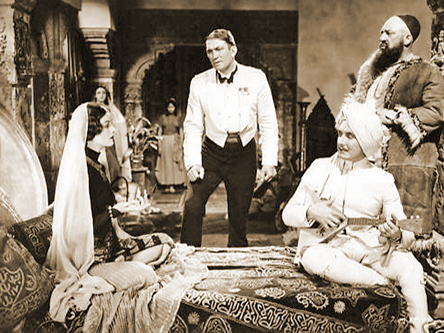| |
 |
| |
Myrna Loy (left), Victor McLaglen (center), Roy D’Arcy
and Walter Long (standing, right).
Photograph: Silent Era image collection.
|
The Black Watch
Also known as Shari, la hechicera in Argentina and Spain; A Guarda Negra in Brazil; Den skotske Kaptajn in Denmark; La garde noire in France; Il black Watch in Italy; King of the Khyber Rifles in the United Kingdom
(1929) United States of America
B&W : Ten reels / 8487 feet / 93 minutes
Directed by John Ford
Cast: Victor McLaglen [Captain Donald Gordon King], Myrna Loy [Yasmani], David Rollins [Lieutenant Malcolm King], Cyril Chadwick [Major Twynes], Roy D’Arcy [Rewa Ghunga], Mitchell Lewis [Mohammed Khan], Walter Long [Harrim Bey], Francis Ford [Major MacGregor], Lumsden Hare [Colonel of the Black Watch], Harry Allen [Sandy], Mary Gordon [Sandy’s wife], Joseph Diskay [Muezzin], Phillips Smalley [the doctor], Pat Somerset [O’Connor, a Black Watch officer], David Percy [the singing Black Watch officer], David Torrence [?] [Marechal or the field marshal]?, Claud King (Claude King) [the general, in India], Frederick Sullivan [the general’s aide], Richard Travers [an adjutant], Randolph Scott [a 42nd highlander, at the table, sitting at the colonel’s right hand], Frank Baker [a 42nd highlander], Arthur Clayton [a 42nd highlander], Gregory Gaye [a 42nd highlander], Bob Kortman (Robert Kortman) [a 42nd highlander], Tom London [a 42nd highlander], Arthur Metcalfe [a 42nd highlander], Jack Pennick [a 42nd highlander], Duke Morrison (John Wayne) [a 42nd highlander], Joyzelle Joyner [an Indian dancer], Frankie Genardi [a little boy], Earle Foxe, Lupita Tovar, [?] ? [Colonel Matranell]
Fox Film Corporation production; distributed by Fox Film Corporation [John Ford Production]. / Produced by Winfield R. Sheehan. Scenario (screenplay) by John Stone, with dialogue by James Kevin McGuinness, from the novel King of the Khyber Rifles by Talbot Mundy. Settings (set design) by William S. Darling. Musical arrangement by William Kernell. Stage direction (dialogue direction) by Lumsden Hare. Assistant director, Edward O’Fearna. Photography (cinematography) by Joseph A. August (Joseph H. August). Second camera operator, Irving Rosenberg. Camera assistants, Harry Webb and J.P. Van Wormer (John Van Wormer). Sound engineers, W.W. Lindsay Jr. and Willard Starr. Stills photography by Clarence Hewitt. Film editor, Alexander Troffey. Presented by William Fox. / © 31 May 1929 by Fox Film Corporation [LP424]. Previewed late April 1929 at the Riverside Theatre in Riverside, California. Premiered 6 May 1929 at the Carthay Circle Theatre in Los Angeles, California. Released 26 May 1929. / Movietone 35mm spherical 1.20:1 format (sound version) and Standard 35mm spherical [?] 1.33:1? format (silent version). Western Electric Movietone sound-on-film synchronized sound system. / Ford’s first talking feature film. John Wayne apparently also worked on the film as a property assistant. The film was released in Denmark on 28 August 1930. The film was released in Finland on 24 April 1931. / Full-sound film.
Drama: Historical.
Survival status: Print exists.
Current rights holder: Public domain [USA].
Keywords: Alcoholism - Animals: Horses - Arrests - Blindness (Inflicted) - Crystal balls - Death (Accidental, Staged) - France - India - Musical instruments: Bagpipes, Harmonicas - Muslims - Pakistan: Khyber Pass - Scots - Soldiers - Synchronized sound film - United Kingdom: England (London), Scotland - Weapons: Rifles, Swords - Whips
Listing updated: 4 May 2025.
References: Film credits, film viewing : Eyman-Wayne p. 44; Gallagher-Ford pp. 31, 47, 55, 60, 61, 64, 68, 70, 72, 86, 105, 123, 207, 287, 465, 498; Sinclair-Ford pp. 40, 43, 59, 240-241; Sweeney-Coming p. 146: ClasIm-225 p. C8 : Website-AFI; Website-IMDb.
Home video: DVD.
|




































